
From DuMont's THE RASTER
Issue of August 1950
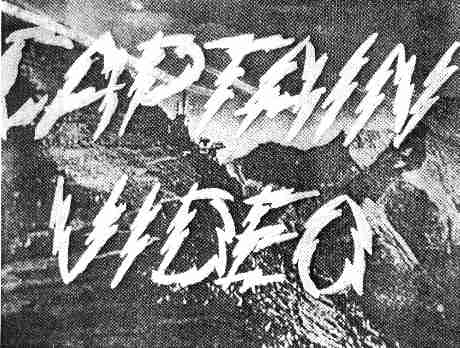 Thanks to DuMont scholar David Weinstein, here for your
viewing pleasure are some incredibly rare behind-the-scenes
images from CAPTAIN VIDEO at the beginning of its second
season. These appeared in DuMont's in-house newsletter for
employees, namely THE RASTER, issue of August, 1950. During
this period, CAPTAIN VIDEO was broadcast 7 to 7:30 PM
weekdays, and 7:30 to 8 PM on Saturdays, "EDST... on the Du
Mont web," as the article says, going on to say "The
tremendously popular feature enjoys... a daily viewer
audience of well over a million. Youthful worshippers grant
this new electronics hero a place heretofore reserved for
such stalwarts as Dick Tracy, Jack Armstrong or Flash
Gordon. Captain Video even outsupers Superman, to the daily
delight of an enchanted audience of small and not-so-small
fry." [Throughout the newsletter, by the way, DuMont is
consistently written as two words, "Du Mont."]
Thanks to DuMont scholar David Weinstein, here for your
viewing pleasure are some incredibly rare behind-the-scenes
images from CAPTAIN VIDEO at the beginning of its second
season. These appeared in DuMont's in-house newsletter for
employees, namely THE RASTER, issue of August, 1950. During
this period, CAPTAIN VIDEO was broadcast 7 to 7:30 PM
weekdays, and 7:30 to 8 PM on Saturdays, "EDST... on the Du
Mont web," as the article says, going on to say "The
tremendously popular feature enjoys... a daily viewer
audience of well over a million. Youthful worshippers grant
this new electronics hero a place heretofore reserved for
such stalwarts as Dick Tracy, Jack Armstrong or Flash
Gordon. Captain Video even outsupers Superman, to the daily
delight of an enchanted audience of small and not-so-small
fry." [Throughout the newsletter, by the way, DuMont is
consistently written as two words, "Du Mont."]
 First Announcer: "Caappptaaiinn Viiddeeeooo! Electronic
Wizard! Master of Time and Space! Guardian of the Safety
of the World!"
Second Announcer: "Fighting for law and order, Captain Video
operates from a mountain retreat-- with secret agents at all
points of the globe. Possessing scientific secrets and
scientific weapons, Captain Video asks no quarter, and gives
none, to the forces of evil! Stand by for Caaappptaaiinn
Viiddeeeooo, and his Video Rangers!"
First Announcer: "Caappptaaiinn Viiddeeeooo! Electronic
Wizard! Master of Time and Space! Guardian of the Safety
of the World!"
Second Announcer: "Fighting for law and order, Captain Video
operates from a mountain retreat-- with secret agents at all
points of the globe. Possessing scientific secrets and
scientific weapons, Captain Video asks no quarter, and gives
none, to the forces of evil! Stand by for Caaappptaaiinn
Viiddeeeooo, and his Video Rangers!"
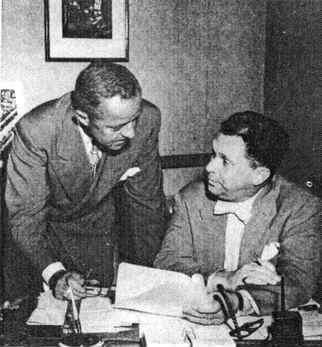 DuMont's program director James L. Caddigan (seated, with
bow-tie) took a very active hand in day-to-day programming,
even writing scripts when emergencies arose. In particular,
CAPTAIN VIDEO was Caddigan's "personal baby," since he
considered himself its co-creator, and it was always
DuMont's top-rated show. Here he makes some suggestions for
forthcoming plot developments to Captain Video's first
scriptwriter, Maurice C. Brockhauser, standing, who billed
himself as M. C. Brock in these days.
DuMont's program director James L. Caddigan (seated, with
bow-tie) took a very active hand in day-to-day programming,
even writing scripts when emergencies arose. In particular,
CAPTAIN VIDEO was Caddigan's "personal baby," since he
considered himself its co-creator, and it was always
DuMont's top-rated show. Here he makes some suggestions for
forthcoming plot developments to Captain Video's first
scriptwriter, Maurice C. Brockhauser, standing, who billed
himself as M. C. Brock in these days.
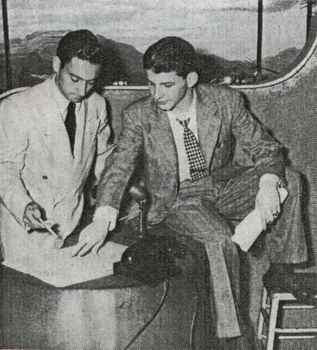 CAPTAIN VIDEO's director Larry White (right, in grey suit) goes
over the day's script with production facilities manager Al Hollander,
specifically to identify the particular props and any
new sets that will be needed in the coming episode.
CAPTAIN VIDEO's director Larry White (right, in grey suit) goes
over the day's script with production facilities manager Al Hollander,
specifically to identify the particular props and any
new sets that will be needed in the coming episode.
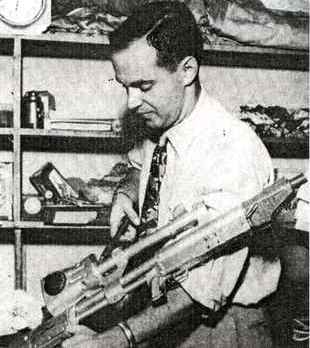 By this time, Captain Video finally had a prop department,
and here Dick Geismar is shown constructing the Captain's
fearsome ray rifle. As near as we can tell from this and
other photos, the rifle consists of the front half of a
wind-up cap-firing machinegun, with the handgrip of a
western-style cap gun sticking out of the open end to
provide a forward grip for the rifle. One plastic pipe goes
back to an oddly-shaped plastic box with a dial on the side.
Two other plastic pipes run from the open rear of the
cap-firing machinegun mechanism to what seems to be mainly
the rear half of the same cap-firing machinegun, with a bit
of extra detailing stuck on here and there. However it was
made, it looks quite effective, and is shown in a large
number of publicity photos from the 1950 - 53 period. For
another view of it, dating from early in 1952 after Al Hodge
took over the role of Captain Video, click here.
Other important behind-the-scenes members of the Captain
Video crew were Rudy Luchek, who painted most of the
scenery, and sound-effects man Ken Rodney. Andy Jaeger,
DuMont's film librarian, picked out the B-Westerns to be
shown in 10 minute segments during every daily broadcast,
and Pete Sarkies did any film editing required. Finally,
Elizabeth Mears handled casting for all the DuMont programs.
All are depicted in the original article. By the way,
throughout the article, DuMont's network is referred to as a
"web."
By this time, Captain Video finally had a prop department,
and here Dick Geismar is shown constructing the Captain's
fearsome ray rifle. As near as we can tell from this and
other photos, the rifle consists of the front half of a
wind-up cap-firing machinegun, with the handgrip of a
western-style cap gun sticking out of the open end to
provide a forward grip for the rifle. One plastic pipe goes
back to an oddly-shaped plastic box with a dial on the side.
Two other plastic pipes run from the open rear of the
cap-firing machinegun mechanism to what seems to be mainly
the rear half of the same cap-firing machinegun, with a bit
of extra detailing stuck on here and there. However it was
made, it looks quite effective, and is shown in a large
number of publicity photos from the 1950 - 53 period. For
another view of it, dating from early in 1952 after Al Hodge
took over the role of Captain Video, click here.
Other important behind-the-scenes members of the Captain
Video crew were Rudy Luchek, who painted most of the
scenery, and sound-effects man Ken Rodney. Andy Jaeger,
DuMont's film librarian, picked out the B-Westerns to be
shown in 10 minute segments during every daily broadcast,
and Pete Sarkies did any film editing required. Finally,
Elizabeth Mears handled casting for all the DuMont programs.
All are depicted in the original article. By the way,
throughout the article, DuMont's network is referred to as a
"web."
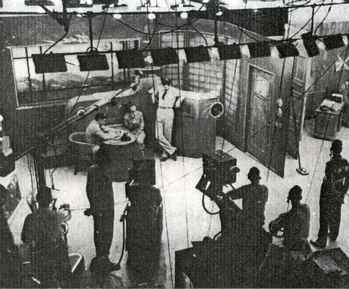 CAPTAIN VIDEO was broadcast live from DuMont's Wanamaker
Studio A. Here's the main set, the Captain's secret
mountain headquarters. On the right side of the photo can
be glimpsed what is probably the office set for Commissioner
of Public Safety Carey, who gave the Video Rangers their
orders. Because the headquarters set was never "struck,"
any 30-minute adventure which didn't involve it tended to
take place on some very cramped temporary sets, some of
which seemed no bigger than a closet. More than once, the
narrow corridors outside the studio were pressed into
service as a setting.
CAPTAIN VIDEO was broadcast live from DuMont's Wanamaker
Studio A. Here's the main set, the Captain's secret
mountain headquarters. On the right side of the photo can
be glimpsed what is probably the office set for Commissioner
of Public Safety Carey, who gave the Video Rangers their
orders. Because the headquarters set was never "struck,"
any 30-minute adventure which didn't involve it tended to
take place on some very cramped temporary sets, some of
which seemed no bigger than a closet. More than once, the
narrow corridors outside the studio were pressed into
service as a setting.
 Here the cast, director and stage hands sit down for a "dry
run" read-through of the day's script. Richard Coogan, who
played Captain Video, is at the right. Third from right is
Don Hastings, the Video Ranger. Director White sits on a
stool in the center. Other actors and crew are
unidentified.
Here the cast, director and stage hands sit down for a "dry
run" read-through of the day's script. Richard Coogan, who
played Captain Video, is at the right. Third from right is
Don Hastings, the Video Ranger. Director White sits on a
stool in the center. Other actors and crew are
unidentified.
 Kids hoped that each episode would find the Captain and the
Ranger at the controls of their speedy rocket-plane X-9.
Here is the only known photo of this set, which consisted
entirely of a piece of canvas painted by Rudy Luchek,
representing the rear bulkhead, and two cardboard steering
wheels! Captain Video and the Ranger sat on four-legged
stools like the one on which Director White is perched in
the previous photo. The "seat backs" were painted
directly onto the bulkhead backdrop. Note that the football
helmets with goggles which are so often identified with
Captain Video were not worn in these days, although Captain
Video did sometimes wear goggles when handling equipment in
his headquarters. Captain Video's first director, Charles
Polacheck, told Roaring Rockets that the goggles and
earphones were adopted as an inexpensive way to give the
actors a "futuristic look."
Kids hoped that each episode would find the Captain and the
Ranger at the controls of their speedy rocket-plane X-9.
Here is the only known photo of this set, which consisted
entirely of a piece of canvas painted by Rudy Luchek,
representing the rear bulkhead, and two cardboard steering
wheels! Captain Video and the Ranger sat on four-legged
stools like the one on which Director White is perched in
the previous photo. The "seat backs" were painted
directly onto the bulkhead backdrop. Note that the football
helmets with goggles which are so often identified with
Captain Video were not worn in these days, although Captain
Video did sometimes wear goggles when handling equipment in
his headquarters. Captain Video's first director, Charles
Polacheck, told Roaring Rockets that the goggles and
earphones were adopted as an inexpensive way to give the
actors a "futuristic look."
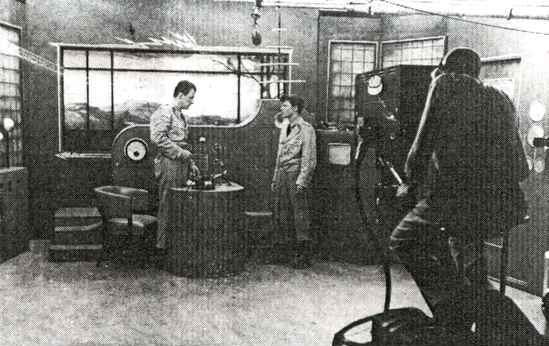 At the end of today's action-packed episode, Captain Video
and the Ranger make a horrifying discovery. How will they
handle it? Tune in tomorrow! Caddigan felt very strongly
that each daily broadcast of CAPTAIN VIDEO should end with a
serial-style cliffhanger. In fact, there were often two
cliff-hangers per broadcast, since the 10-minute B-Western
clip could often be edited to involve a cliffhanger at
clip's end!
Return to CAPTAIN VIDEO.
At the end of today's action-packed episode, Captain Video
and the Ranger make a horrifying discovery. How will they
handle it? Tune in tomorrow! Caddigan felt very strongly
that each daily broadcast of CAPTAIN VIDEO should end with a
serial-style cliffhanger. In fact, there were often two
cliff-hangers per broadcast, since the 10-minute B-Western
clip could often be edited to involve a cliffhanger at
clip's end!
Return to CAPTAIN VIDEO.











